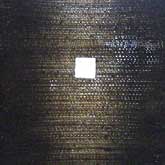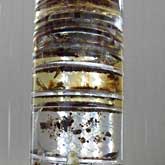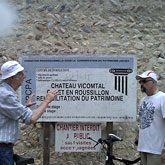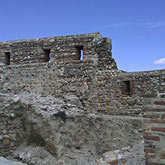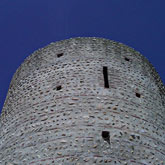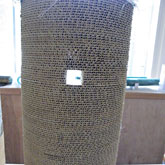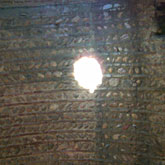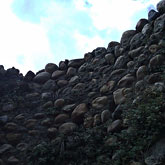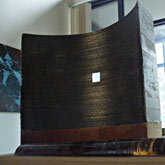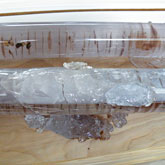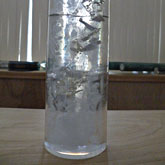ICE CORE SAMPLING SCULPTURES & LAYERED CARDBOARD SCULPTURES
Ice Castle and Ice Cores
In May of 2010, while bicycling for the day in the South of France, I happened to come upon a significant ice-related medieval-era phenomenon that ties in with my sculptural art and provides amazing coincidences with my work over the past twenty years.
I cycled past an 11th century castle in Canet that had been built in 1013 and was currently under restoration. The project foreman on the historic preservation site, for some unknown but very much appreciated reason, came out to greet me and invited me in for a walk-through, which was normally forbidden to the public. Specifically, he offered to show me the "Ice Tower" or the "Place where they kept the ice". His coming out of the site and inviting me to tour the project was a significant gesture in itself, while his offer to view the "Place of Ice" - with ice being a focal subject of my sculptures and paintings over the past two decades - was a huge coincidence, to say the least.
The coincidental significance was that this castle had been built around an enormous ice repository that was filled by manual labor from the Pyrenees mountain region. This was a very unusual find in that it seems that there are no other castles as such in existence, and the historical record of an ice vault of this enormous proportion is rare if non-existent. The unique find inspired me to create another group of my Ice Core Sculptures incorporating material and DNA from significant historical times and geographic locations, and I proceeded to interview the foreman about the structure, as well as collected stone samplings and powder scrapings from the structure itself. My intent was to create an Ice Core Sculpture that featured imbedded within it sampling material from an historic stone structure that once held ice material within it. So the castle would be housed in the Ice Core, as the ice had once been housed in the Castle. I then returned to my studio in Oregon to complete this new series as part of my Mineral / DNA Ice Core Sampling Sculptures.
Similarities of Structure and Sculptures
The Canet-En-Roussillon Castle features a giant cylindrical chamber that housed ice carried down from the Pyrenees Mountains, as well as square window-type openings in the stone tower and surrounding walls. The few historical references made to this medieval structure point to ice preservation as the purpose of collecting and containing an enormous amount of ice, and I have attempted to further understand and portray the purpose for the collection of this ice.
In addition to the "ice" theme and purpose shared in common by this Castle and my sculptures, there are also structural and architectural similarities between this stone structure and my sculptural forms which I had completed eight years prior to visiting the castle. The two most striking architectural details that are similar to my early sculpture forms are: 1) Square "window" openings within the walls, as in my sculptures and paintings; and 2) Constructed and layered stone stacking, as in my cardboard sculptures.
The Canet Castle Project is especially important to me because of this similarity to my sculptures which I had completed in 2002 - eight years prior to visiting the castle - and which have a coincidental visual theme in common with the castle ruins. While visiting the site, I had actually experienced a sense of déjà vu and slight dizziness after realizing the dynamics and significance of the historical and architectural similarities between these castle ruins and my early sculptural forms. The chief detail was the square window-like apertures mimicking the square forms in my sculptures constructed in cardboard layers, and the round circumference of the tower emulating my round tower-like sculptures.
Collecting and Imbedding the Historic Stone Sampling
While on site, as previously mentioned, I had been allowed to scrape areas of the wall and floor material for collection for my Ice Core Sculptures, to be later imbedded into the resin material which I use to create my forms. The foreman was kind enough to collect some of the stones and powder for me himself, and this was a great treasure. The rust color was the most notable quality of this stone, and is visually beautiful.
This predominant hue of rust-red provided a new visual variant on the Ice Core group I had completed thus far. It also established a new direction and platform to my Ice Core statement on ice and snow relevancy. For the first time, it also expanded the artistic dialogue beyond Polar concerns. This group is particularly interesting as it marks a man-made invention of ice preservation and sequestration in a visual and historic time, as Castle Canet dates back to 1013 AD period for its conception.
An Early Invention of Ice Preservation and Indication of Environmental/Climate Initiative
Le Château Vícomtal De Canet-En-Roussíllon became the home of Viscount Canet in the 12th century, approximately 1197AD. The Castle siege took place in approximately 1343AD. Castle Canet was later deconstructed by Napoleon's son in order to build the city infrastructure. Among its ruins, the ice tower still stands erect and intact, as well as its underground storage area, many of its walls, and maze of chambers. Evidence remains that the main architectural detail of a central vertical tower was built and designed to contain snow/ice-pack using a man-made receptacle.
The ice and snow material was believed to have been carted and crafted from some considerable distance from the Pyrenees Mountain Range by mule cart for a continuous period of 300 to 400 years, establishing an ice repository. This permanent ice repository is believed to have provided an economic and domestic agricultural refrigeration process for the people of the Canet village.
This valuable supply of ice was also recognized as a natural valuable resource and possibly a natural treasure of environmental importance. This repository is an indication of an early recognition of valuable natural material, beneficial to human habitat and existence. It signifies an early historic climate initiative parameter.
Tower Design and Natural Treasure
Within the interior secular detail, the hollow circular walls are constructed in an ordered stacked sequence that also illustrates a visual aesthetic of considerable order and purpose. At the top of the construction vault is an opening that was provided for access to ice/snow-pack delivery.
There is considerable deliberate design of portals or windows at set heights for observation, which are framed elaborately with stones in the same fashion as the walls. The red stonework with round rocks alternating in flat stone layers provides a decorative and pleasing pattern.
Transition of Castle Detail Into Sculptural Context
My approach in creating the Canet Castle Ice Core Sculptures is to take the Castle material collected on-site at Canet, and organize the red stone sampling into a new Ice Core group. This is accomplished in the same fashion that I have produced the Polar Ice Core design.
Because of the unique and surprising Castle find, I feel that the Canet Chateau will fit well with my other Ice Core Sampling Sculptures completed. As an historic repository of ice, this subject reinforces and enhances the Ice Core group by providing historic reference particular to ice and snow. It also provides historic recognition of human attitudes and ideas on ice and snow as a valuable resource in historic times.
Sculpture Interpretation
While keeping consistent with the imbedded material/DNA Ice Core group, these new Canet works should also keep the thematic and visual approach consistent through emphasizing the ice and snow importance as the control devise.
I have incorporated the stone scraping material taken from the interior Castle wall, and imbedded the material in very thin wafer layers placed in succession at vertical layers. This achieves a semblance of realistic DNA material representing Arctic layered material. I have ground the stone collected at Canet into a fine pulverized dust and made thin wafer pancakes with resin pours in succession.
After set-up and casting, I arranged the wafers in vertical stacks by casting them in half-tubular arrangements, which, after devising these half-cores, I have since found actually emulate geological cores.
The finished sculptures portray the Canet Castle material as sequential matter extracted by coring, with layers of stone material mimicking DNA arrangement.
The red stone also tones the color into Ice Cores Sculpture hues that are unique to French castle material, terrain, and soil.
Imbedded Dialogue on Historical Significance
In addition to the completed Canet Ice Core Group featuring stone material sampling sculptures, I would also like to add three or four Cores featuring French dialogue about the Castle site, which I have requested from the project reconstruction manager, who is currently writing his ideas and thoughts about the Castle for me to imbed into this additional group. These opinions, which will be written in French on archival paper, will then be presented as pages of dialogue deconstructed by me and imbedded into the Core forms, following the same process as the other Polar works I have created, with the exception that these will be mixed with a color that is similar to the rock hue in the resin catalyzed stone samples.
I would like to capture the concept of historic record through these dialogue Canet Castle Ice Cores, and, as in my Polar Dialogue Ice Cores, will also include the visual ability to read the French writings through the walls of these Cores.
Portraying Historical and Environmental Significance Through the Canet Ice Cores
I believe that the chance encounter with an historic architectural ruin that provides a link to current climate Polar and environmental questions, specific to collecting and recognizing the value of deep cold resources, provides an honest artistic presentation.
Furthermore, I believe that the visual similarity of this historic structure to my early sculptures further strengthens and solidifies the significance of this series of art works.
Early concern with, and recognition of, deep cold is fundamentally presented by the 11th century architectural record of the Canet Castle ruins, and is portrayed in my new series of Canet Ice Cores.

